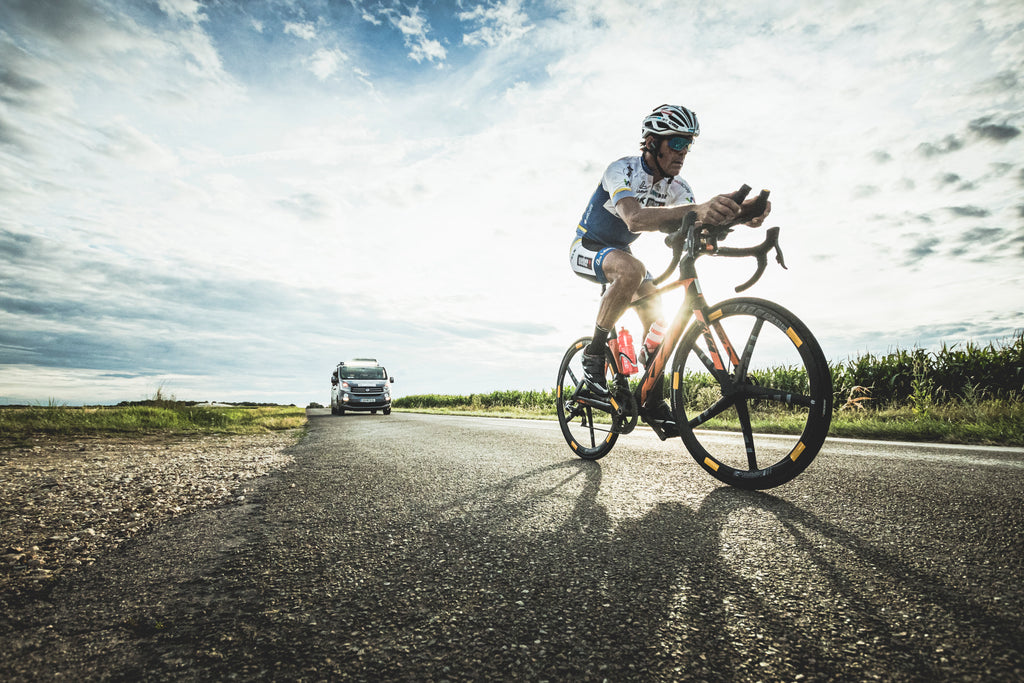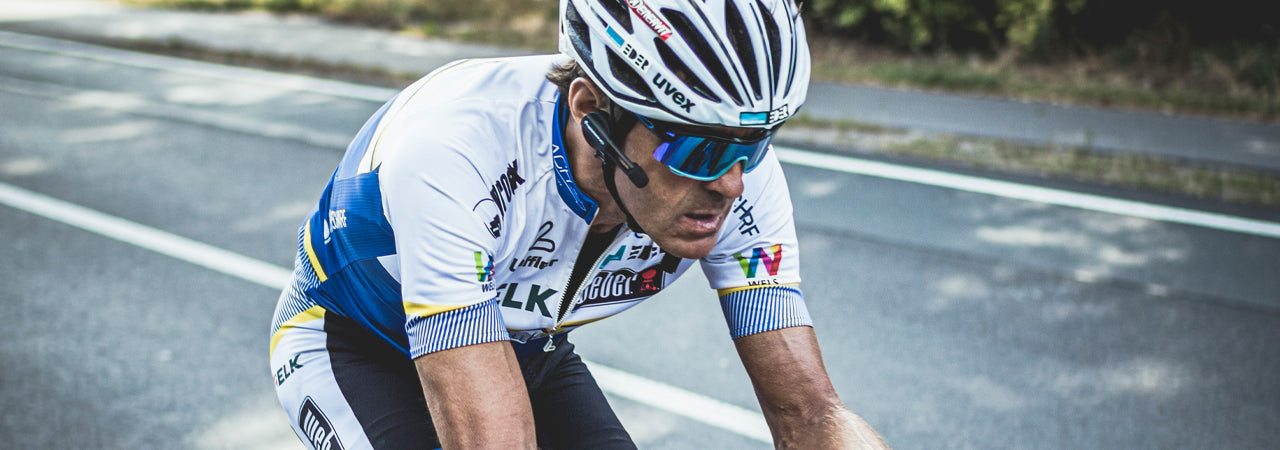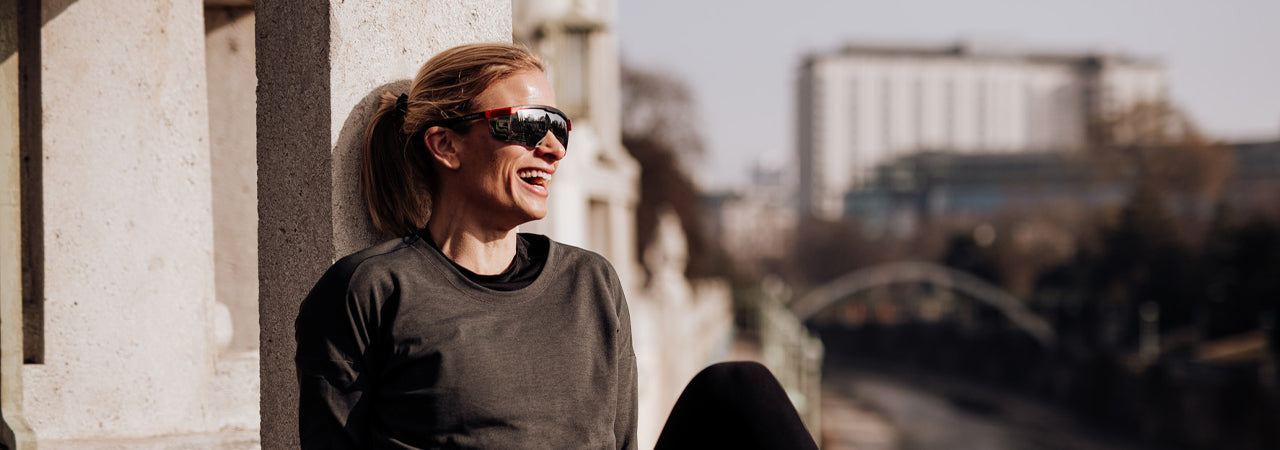When cycling, the right equipment is extremely important so that the fun doesn't fall by the wayside. J-Athlete & Extreme athlete Wolfgang Fasching reveals what to look out for when it comes to cycling equipment. He took part in the Race Across America (RAAM) 8 times and won it three times. Wolfgang knows like no other what is important. We hope you enjoy biking.
The right bike
First and foremost, a bike has to suit you. The most important thing is the geometry, i.e. the frame shape and size, the height of the seat and the steering wheel rod, the handlebar width and much more.
"The fun begins when I feel comfortable on my bike!"
You will not get all this adapted on the Internet. That is why my most important tip is: Buy your bike from a specialist shop and under no circumstances online. Anything that you may save online will ultimately cost you fun and well-being on the bike. Everything is precisely measured in the bike shop and you get competent answers to your questions.
Before you go to a bike shop, however, you should definitely consider the terrain on which you want to move and with what goal you want to practice cycling. You should also observe the following basic rules when choosing your bike:
- Brakes: Whether you are looking for a mountain bike or a racing bike with disc brakes, you're always on the right track. Due to their higher surface pressure, disc brakes have better braking performance in wet conditions and the brake pads are very durable.
- Frame material: A frame made of carbon is the premier class. It's the best possible combination of weight and robustness. If that's too expensive for you, I recommend a bike with an aluminum frame.
- Gear shift: The gear shift must be tailored to the purpose. The type of operation should be selected according to your own preferences. Just try out the different operating modes and see which one you feel most comfortable with.
- Tire width: Better to choose a slightly wider tire, but with a little less air. For a racing bike, for example, a tire with a width between 23 and 25 mm is recommended.
- Saddle: Choosing the right saddle can become a science. Beginners should definitely not use a racing saddle. A saddle shouldn't be too hard or too soft, you definitely have to try out what's best for you.
What should a good bike cost? The price range and the product selection are very large and you can get lost very quickly. I do not recommend beginners to pick up a high-end bike straight away, but to choose a solid bike that has everything they need. A decent entry-level racing bike, for example, shouldn't cost more than € 2500.

The cycling clothing
The importance of cycling clothing is unfortunately very often underestimated. Especially on longer bike tours it is important to wear comfortable and functional clothing.
"I'm naked under the cycling shorts!"
Starting with the pants, it pays not to choose the cheapest product and to make sure that a soft plastic insert is sewn in. Your butt will thank you! A surprising number of people believe that you can also wear underpants under cycling shorts. BUT this can lead to friction and you sweat a lot more. Therefore you should not wear underpants under your cycling shorts.
By the way: The buttocks are muscles and they should be trained. If you often have pain in your backside while cycling, this is an indication that you need to better prepare your buttocks for the strain. It is therefore important, especially for beginners, to start with shorter, leisurely tours and gradually increase.
The cycling gloves are also of great importance. Here, too, the rule applies that the longer the journey, the more important your gloves are. They relieve the ball of the hand and should a fall occur, the gloves protect the palms of the hands when they are supported. The fingers should always be free. Only downhill mountain bikers or in winter you should wear gloves that enclose your fingers.

You should use a tight-fitting and air-permeable product for the undershirt. This ensures good sweat absorption and quick drying. Always dress a little warmer than you think so that you don't freeze while driving. One often underestimates the wind and external conditions. Clothing with zippable sleeves and leg warmers are highly recommended here, in order to be able to react immediately to changing conditions. Your bike jersey should have pockets accordingly, because this way you can stow clothes that you are currently not wearing. In addition, an energy bar, muesli bar or banana should also be in your pockets as an energy reserve.
The cycling shoes
I definitely recommend pedals with clips and shoes. The power transfer is optimal and you will have a lot more fun while biking.
"It hits everyone once! That is completely normal. ”
Warning: If you drive slowly, want to dismount, drive a very tight curve or turn around, it is generally better to remove your shoes from the clips. So you can get off the bike safely. If you forget that, you will inevitably fall over! But don't worry: it hits everyone at one point or another. This is completely normal. But you will definitely remember it afterwards!

The helmet
The helmet is absolutely the most important thing for your safety. Of course, it must conform to the norm and sit correctly. Many are sloppy and leave the chin straps too loose. Everything has to be firmly in place here, otherwise it will end fatally in the event of a fall. If you often drive in the morning or at dusk, I recommend a net in the inner helmet to keep insects away.
The Mini Toolkit
As a cyclist, you must always have a mini toolkit with you. It should definitely contain an air cartridge, assembly lever and a reserve hose.
"Everyone who rides a bike should be able to do small repairs themselves!"
Because you should be able to fix a flat tire yourself. It's like a first aid course! I recommend trying out a tire change at home, so that you are prepared in the event of an accident. Of course, a short visual inspection of the bike, especially the tires, must be carried out before and after every ride.
The heart rate monitor
A heart rate monitor makes perfect sense. You can use it to check and adjust your load area. However, this requires a sporting performance test, which I would definitely recommend regardless of that. Warning: heart rate values cannot be compared, because every body is different!
The sunglasses
Last but not least, good sunglasses are a constant companion on bike tours. Good cycling goggles have to fit snugly on both the nose and ears and must not pinch, even if you are wearing a helmet! In addition, I recommend glasses with anti-reflective lenses to absorb annoying sun rays from behind and good ventilation or an anti-fog coating to minimize tarnishing in changing weather conditions. I packed all of these features into my own signature glasses from J. Athletics, the Victory.





